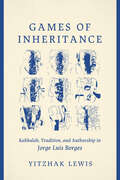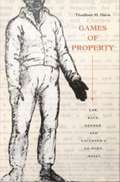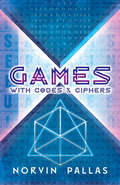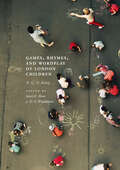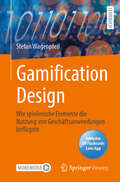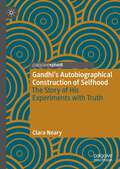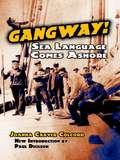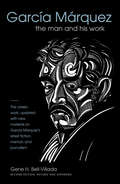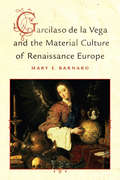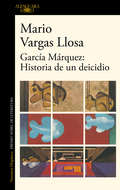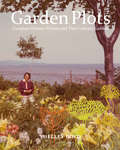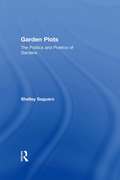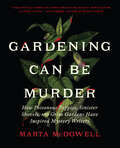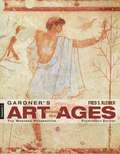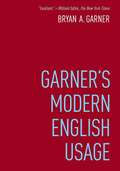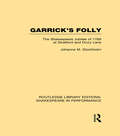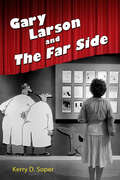- Table View
- List View
Games of Inheritance: Kabbalah, Tradition, and Authorship in Jorge Luis Borges
by Yitzhak LewisGames of Inheritance explores the thought of Argentine author and public intellectual Jorge Luis Borges (1899–1986) on questions of authorship and literary tradition. The book focuses on Borges’s engagement with Jewish literary and intellectual traditions, highlighting the role of this engagement in developing and expressing his views on these questions. The book argues that the primary relevance of Borges’s persistent reference to “the Judaic” is not for understanding his attitude toward Jews and Judaism but for understanding his position in contemporary Argentinian debates about nationalism and literature, empire and postcolonialism, and populism and aesthetics. By broadening the frame of Borges and the Judaic, this book shifts the scholarly focus to the poetic utility of Borges’s engagement with Jewish literary and intellectual traditions. This allows a better understanding of the nuance of his views on the issues that most animate his oeuvre: authorship and writing, literature and tradition.
Games of Property: Law, Race, Gender, and Faulkner's Go Down, Moses
by Thadious M. DavisIn Games of Property, distinguished critic Thadious M. Davis provides a dazzling new interpretation of William Faulkner's Go Down, Moses. Davis argues that in its unrelenting attention to issues related to the ownership of land and people, Go Down, Moses ranks among Faulkner's finest and most accomplished works. Bringing together law, social history, game theory, and feminist critiques, she shows that the book is unified by games--fox hunting, gambling with cards and dice, racing--and, like the law, games are rule-dependent forms of social control and commentary. She illuminates the dual focus in Go Down, Moses on property and ownership on the one hand and on masculine sport and social ritual on the other. Games of Property is a masterful contribution to understandings of Faulkner's fiction and the power and scope of property law.
Games with Codes and Ciphers
by Norvin PallasIntrigue your friends with birthday prophecies, spin a mystifying wheel of fortune, travel through the Valley of Fear, and take on Dad's Challenge! This collection presents scores of intriguing brainteasers from the fascinating world of codes and ciphers. Assembled by a master puzzle-maker, these activities are inspired by sources as diverse as the Sherlock Holmes stories and the procedures of the U.S. Navy. Code-breakers ages 8 and up can go on cryptic treasure hunts, engage in surreptitious writing, send secret messages, and learn all about fingerprinted words. Other puzzles feature a foolproof code (perfect for keeping a private diary), three-letter patterns, a nonreciprocal alphabet, and much more. The stimulating and entertaining challenges include easy-to-follow directions as well as complete solutions.
Games, Rhymes, and Wordplay of London Children
by N. G. KelseyThis book presents a unique annotated collection of some 2000 playground games, rhymes, and wordplay of London children. It charts continuity and development in childlore at a time of major social and cultural change and offers a detailed snapshot of changes in the traditions and language of young people. Topics include: starting a game; counting-out rhymes; games (without songs); singing and chanting games; clapping, skipping, and ball bouncing games; school rhymes and parodies; teasing and taunting; traditional belief and practice; traditional wordplay; and a concluding miscellany. Recorded mainly in the 1980s by primary schoolteacher Nigel Kelsey, transcribed verbatim from the children’s own words, and accompanied by extensive commentaries and annotation, the book sets a wealth of new information in the wider historical and contemporary context of existing studies in Britain, Ireland, and other parts of the English-speaking world. This valuable new resource will open new avenues for research and be of particular interest to folklorists and linguists, as well as to those working across the full spectrum of social, cultural, and educational studies.
Gamification Design: Wie spielerische Elemente die Nutzung von Geschäftsanwendungen beflügeln
by Stefan WagenpfeilGamification hat längst den Bereich der Computerspiele verlassen und ist zu einem wichtigen Werkzeug geworden, um Anwendungen zu entwickeln, die Benutzer*innen fördern, fordern und fesseln. In diesem Buch werden die Konzepte der Gamification, grundlegende Modelle und deren Anwendungsbereiche behandelt. Zudem erhalten Sie konkrete Handlungsempfehlungen und Herangehensweisen für die praktische Umsetzung. Sie benötigen keine Programmierkenntnisse, sollten jedoch Interesse an technischen und theoretischen Zusammenhängen mitbringen, um mithilfe von Gamification gezielt Ihre Anwendungen zu planen und umzusetzen. Erfahren Sie, wie Sie mit Gamification mehr Akzeptanz und Effizienz erreichen können. Das Lehrbuch führt ein solides wissenschaftliches Fundament ein, auf dem dann die tiefergehenden Konzepte angewandt und anhand diverser Fallbeispiele illustriert werden. Es eignet sich für Studierende der Informatik, Wirtschaftsinformatik oder Betriebswirtschaft (mit technischem Interesse), sowie IT-Manager, Software-Architekten oder Product Owner in Unternehmen. Zusätzliche Fragen per App: Laden Sie die Springer-Nature-FlashcardsApp kostenlos herunter und nutzen Sie exklusives Zusatzmaterial, um Ihr Wissen zu prüfen.
Gaming the Stage: Playable Media and the Rise of English Commercial Theater (Theater: Theory/Text/Performance)
by Gina BloomRich connections between gaming and theater stretch back to the 16th and 17th centuries, when England's first commercial theaters appeared right next door to gaming houses and blood-sport arenas. In the first book-length exploration of gaming in the early modern period, Gina Bloom shows that theaters succeeded in London's new entertainment marketplace largely because watching a play and playing a game were similar experiences. Audiences did not just see a play; they were encouraged to play the play, and knowledge of gaming helped them become better theatergoers. Examining dramas written for these theaters alongside evidence of analog games popular then and today, Bloom argues for games as theatrical media and theater as an interactive gaming technology. Gaming the Stage also introduces a new archive for game studies: scenes of onstage gaming, which appear at climactic moments in dramatic literature. Bloom reveals plays to be systems of information for theater spectators: games of withholding, divulging, speculating, and wagering on knowledge. Her book breaks new ground through examinations of plays such as The Tempest, Arden of Faversham, A Woman Killed with Kindness, and A Game at Chess; the histories of familiar games such as cards, backgammon, and chess; less familiar ones, like Game of the Goose; and even a mixed-reality theater videogame.
Gandhi's Printing Press
by Isabel HofmeyrAt the same time that Gandhi, as a young lawyer in South Africa, began fashioning the tenets of his political philosophy, he was absorbed by a seemingly unrelated enterprise: creating a newspaper. Gandhiâe(tm)s Printing Press is an account of how this project, an apparent footnote to a titanic career, shaped the man who would become the world-changing Mahatma. Pioneering publisher, experimental editor, ethical anthologistâe"these roles reveal a Gandhi developing the qualities and talents that would later define him. Isabel Hofmeyr presents a detailed study of Gandhiâe(tm)s work in South Africa (1893âe"1914), when he was the some-time proprietor of a printing press and launched the periodical Indian Opinion. The skills Gandhi honed as a newspapermanâe"distilling stories from numerous sources, circumventing shortages of typeâe"influenced his spare prose style. Operating out of the colonized Indian Ocean world, Gandhi saw firsthand how a global empire depended on the rapid transmission of information over vast distances. He sensed that communication in an industrialized age was becoming calibrated to technological tempos. But he responded by slowing the pace, experimenting with modes of reading and writing focused on bodily, not mechanical, rhythms. Favoring the use of hand-operated presses, he produced a newspaper to contemplate rather than scan, one more likely to excerpt Thoreau than feature easily glossed headlines. Gandhiâe(tm)s Printing Press illuminates how the concentration and self-discipline inculcated by slow reading, imbuing the self with knowledge and ethical values, evolved into satyagraha, truth-force, the cornerstone of Gandhiâe(tm)s revolutionary idea of nonviolent resistance.
Gandhi’s Autobiographical Construction of Selfhood: The Story of His Experiments with Truth
by Clara NearyThis book addresses the topics of autobiography, self-representation and status as a writer in Mahatma Gandhi's autobiographical work The Story of My Experiments with Truth (1927, 1929). Gandhi remains an elusive figure, despite the volumes of literature written on him in the seven decades since his assassination. Scholars and biographers alike agree that “no work on his life has portrayed him in totality” (Desai, 2009), and, although “arguably the most popular figure of the first half of the twentieth century” and “one of the most eminent luminaries of our time,” Gandhi the individual remains “as much an enigma as a person of endless fascination” (Murrell, 2008). Yet there has been relatively little scholarly engagement with Gandhi’s autobiography, and published output has largely been concerned with mining the text for its biographical details, with little concern for how Gandhi represents himself. The author addresses this gap in the literature, while also considering Gandhi as a writer. This book provides a close reading of the linguistic structure of the text with particular focus upon Gandhi’s self-representation, drawing on a cognitive stylistic framework for analysing linguistic representations of selfhood (Emmott 2002). It will be of interest to stylisticians, cognitive linguists, discourse analysts, and scholars in related fields such as Indian literature and postcolonial studies.
Gangway!: Sea Language Comes Ashore
by Paul Dickson Joanna Carver ColcordLandlubbers use a remarkable number of terms and expressions that originated at sea. This readable dictionary of maritime vernacular explains the meanings behind "catspaw," "kick the bucket," "palaver," "three sheets in the wind," and other curious lingo. It's a great gift for any sailor or lover of language. "Entertaining and informative." -- The Washington Post.
Garbage Day with Paige
by Joan Fleiss Kaplan"These appealing decodable stories nurture early literacy development, which translates into building new readers' self-confidence. This, in turn, quickens the pace at which genuine reading comprehension is achieved ..."--Epsbooks.com.
Garcia Marquez: The Man and His Work, Second Edition
by Gene H. Bell-VilladaGabriel Garcia Marquez is one of the most influential writers of our time. His unique literary creativity is rooted in the history of the region, with all its social and political implications. In this beautifully written examination of Garcia Marquez and his work, Gene Bell-Villada traces the major forces that have shaped the Colombian novelist and describes his life, his personality, and his political opinions. He considers Garcia Marquez's place in world literature and analyzes his short fiction and all of his novels from the great and complexOne Hundred Years of Solitude-- a cultural phenomenon the likes of which we have seldom seen -- throughLove in the Time of Cholera. He shows why Garcia Marquez has achieved a confluence of high art and popular success that is virtually unique in the twentieth century. Bell-Villada examines the narrative works of Garcia Marquez for their historical and human content, for their literary technique and structure, and for their expert use of fantasy, ribaldry, humor, and satire. He describes Garcia Marquez as a global phenomenon and as a local boy, as a Nobel Laureate and as a Latin American Everyman, as a political writer and as a novelist of love. The book will appeal to a broad spectrum of readers -- generalists who enjoy his novels, teachers and students, and literary specialists and Latin Americanists investigating the culture and politics of the region.
Garcilaso de la Vega and the Material Culture of Renaissance Europe
by Mary E BarnardGarcilaso de la Vega and the Material Culture of Renaissance Europe examines the role of cultural objects in the lyric poetry of Garcilaso de la Vega, the premier poet of sixteenth-century Spain. As a pioneer of the "new poetry" of Renaissance Europe, aligned with the court, empire, and modernity, Garcilaso was fully attuned to the collection and circulation of luxury artefacts and other worldly goods. In his poems, a variety of objects, including tapestries, paintings, statues, urns, mirrors, and relics participate in lyric acts of discovery and self-revelation, reveal memory as contingent and unstable, expose knowledge of the self as deceptive, and show how history intersects with the ideology of empire.Mary E. Barnard's study argues persuasively that the material culture of early sixteenth-century Europe embedded within Garcilaso's poems offers a key to understanding the interplay between objects and texts that make those works such vibrant inventions.
García Márquez
by Gene H. Bell-VilladaGabriel Garcia Marquez is one of the most influential writers of our time, with a unique literary creativity rooted in the history of his native Colombia. This revised and expanded edition of a classic work is the first book of criticism to consider in detail the totality of Garcia Marquez's magnificent oeuvre.In a beautifully written examination, Gene Bell-Villada traces the major forces that have shaped the novelist and describes his life, his personality, and his politics. For this edition, Bell-Villada adds new chapters to cover all of Garcia Marquez's fiction since 1988, from The General in His Labyrinth through Memories of My Melancholy Whores, and includes sections on his memoir, Living to Tell the Tale, and his journalistic account, News of a Kidnapping. Moreover, new information about Garcia Marquez's biography and artistic development make this the most comprehensive account of his life and work available.
García Márquez: Historia de un deicidio
by Mario Vargas LlosaGabriel García Márquez por Mario Vargas Llosa Nueva edición de una obra mítica e inencontrable cuando se cumplen cincuenta años de su primera publicación «Cada novela es un deicidio secreto, un asesinato simbólico de la realidad.» Publicado a comienzos de la década de los setenta y desaparecido de las librerías desde hace muchos años, este ensayo, que en su origen fue la tesis que le valió a Vargas Llosa en 1971 el título de doctor por la Universidad Complutense de Madrid, muestra la admiración del Nobel peruano por García Márquez y por su novela Cien años de soledad. En él se analiza en profundidad la obra del autor colombiano, compañero de Vargas Llosa en el boom de la literatura latinoamericana. «Obsesiva; recurrente, una intención central abraza la obra de García Márquez, una ambición única que sus ficciones van desarrollando a saltos y retrocesos, desde perspectivas diferentes y con métodos distintos. Este denominador común hace que sus cuentos y novelas puedan leerse como fragmentos de un vasto, disperso, pero al mismo tiempo riguroso proyecto creador, dentro del cual encuentra cada uno de ellos su plena significación. Esta voluntad unificadora es la de edificar una realidad cerrada, un mundo autónomo. »Un escritor no elige sus temas, los temas lo eligen a él. García Márquez no decidió, mediante un movimiento libre de su conciencia, escribir ficciones a partir de sus recuerdos de Aracataca. Ocurrió lo contrario: sus experiencias de Aracataca lo eligieron a él como escritor. Un hombre no elige sus “demonios”: le ocurren ciertas cosas, algunas lo hieren tanto que lo llevan, locamente, a negar la realidad y a querer reemplazarla. Esas “cosas”, que están en el origen de su vocación, serán también su estímulo, sus fuentes, la materia a partir de la cual esa vocación trabajará. No se trata de reducir el arranque y el alimento de la vocación a una experiencia única. Pero en el caso de García Márquez la naturaleza de su obra permite afirmar que aquella experiencia, sin negar la importancia de otras, constituye el impulso principal para su tarea de creador.» Mario Vargas Llosa La crítica ha dicho:«La escritura de Mario Vargas Llosa ha dado forma a nuestra imagen de Sudamérica y tiene su propio capítulo en la historia de la literatura contemporánea. En sus primeros años, fue un renovador de la novela, hoy, un poeta épico.»Per Wästberg, presidente del Comité Nobel «El retrato indirecto de un escritor brillante que tuvo la generosidad de leer a su contemporáneo como si fuera un clásico. Una rareza.»J. Rodríguez Marcos, Babelia «Se diría que Vargas Llosa sabe más sobre García Márquez que el propio García Márquez. Hacen pensar en un museo que se construyera para albergar una obra de arte y, a la postre, la arquitectura del edificio fuera tanto o másvaliosa que la obra que guarda.»Clarín «Entre nuestros contemporáneos, nadie mejor que el Premio Nobel de 2010 ha sido capaz de seducir amablemente a una gran masa de lectores contándoles historias llenas de sentido con una prosa tan bella como eficaz. Y con un dominio de las estrategias narrativas que la evolución de la literatura del siglo XX instrumentó para superar la manera de hacer novela en el siglo anterior.»Darío Villanueva «Igual que determinados artículos de los sucesivos volúmenes de Contra viento y marea (o que sus libros sobre Victor Hugo o sobre Onetti, o que algún libro en apariencia menor, como las Cartas a un joven novelista), esos libros contienen la más compleja, apasionada y persuasiva visión de la novela y del oficio de novelista de la que tengo noticia; también contienen el mejor estímulo que un novelista puede encontrar para escribir, un estímulo solo inferior al que contienen las propias novelas de Vargas Llosa.»Jav
Garden Plots
by Shelley BoydCanadian literature has long been preoccupied with the wilderness and the landscape, but the garden has remained neglected terrain. In Garden Plots, Shelley Boyd focuses on private, domestic gardens tended by individual gardeners, to show how modest, everyday spaces provide fertile grounds for the imagination. Combining the history of gardening with literary analysis, Garden Plots explores the use of the garden motif in the works of five authors: Susanna Moodie, Catharine Parr Traill, Gabrielle Roy, Carol Shields, and Lorna Crozier. With works spanning the nineteenth to twenty-first centuries, these writers reveal the associations between the arts of writing and gardening, the evolving role of the female gardener, and the changes that take place in Canada's literary gardens over time. With the task of understanding our connection to the physical environment becoming increasingly important, Garden Plots explores the subtle relations between place and narrative. This fresh, literary approach to Canada's gardening culture reveals that gardens grow and change not simply in the earth, but also in the pages of our texts.
Garden Plots: Canadian Women Writers and Their Literary Gardens
by Shelley BoydCanadian literature has long been preoccupied with the wilderness and the landscape, but the garden has remained neglected terrain. In Garden Plots, Shelley Boyd focuses on private, domestic gardens tended by individual gardeners, to show how modest, everyday spaces provide fertile grounds for the imagination. Combining the history of gardening with literary analysis, Garden Plots explores the use of the garden motif in the works of five authors: Susanna Moodie, Catharine Parr Traill, Gabrielle Roy, Carol Shields, and Lorna Crozier. With works spanning the nineteenth to twenty-first centuries, these writers reveal the associations between the arts of writing and gardening, the evolving role of the female gardener, and the changes that take place in Canada's literary gardens over time. With the task of understanding our connection to the physical environment becoming increasingly important, Garden Plots explores the subtle relations between place and narrative. This fresh, literary approach to Canada's gardening culture reveals that gardens grow and change not simply in the earth, but also in the pages of our texts.
Garden Plots: The Politics and Poetics of Gardens
by Shelley SaguaroShelley Saguaro's unique book illustrates the persistent presence of gardens in literature. Gardens in fiction do not simply represent a familiar theme, Saguaro contends, but are bound up with wider aesthetic and ideological issues. As with literary forms, so too are gardens subject to transformations. Encompassing a wide array of twentieth- and twenty-first century authors, including Virginia Woolf, Eudora Welty, Carol Shields, J. M. Coetzee, Toni Morrison, Leslie Marmon Silko, Jamaica Kincaid, Don DeLillo, and Philip K. Dick, this book's preoccupations are signalled in the evocatively titled chapters: Botanical Modernisms; Natural History and Postmodern Grafting; Postcolonial Landscapes; How Does Your Cyber Garden Grow?; and Coevolutionary Histories - the Poetics of a Paradox. Informed by postcolonial, formalist, feminist, and psychoanalytic theories, Garden Plots is a must read for all those alive to the space gardens inhabit in the literary landscape.
Garden of Lies
by Eileen GoudgeWhen Sylvie Rosenthal exchanges her newborn daughter for another baby during a hospital fire, hoping to hide her own secret, the lives of two families are impacted.
Gardening Can Be Murder: How Poisonous Poppies, Sinister Shovels, and Grim Gardens Have Inspired Mystery Writers
by Marta McDowellThis fun, engrossing book takes a look at the surprising influence that gardens and gardening have had on mystery novels and their authors. With their deadly plants, razor-sharp shears, shady corners, and ready-made burial sites, gardens make an ideal scene for the perfect murder. But the outsize influence that gardens and gardening have had on the mystery genre has been underappreciated. Now, Marta McDowell, a writer and gardener with a near-encyclopedic knowledge of the genre, illuminates the many ways in which our greatest mystery writers, from Edgar Allen Poe to authors on today&’s bestseller lists, have found inspiration in the sinister side of gardens. From the cozy to the hardboiled, the literary to the pulp, and the classic to the contemporary, Gardening Can Be Murder is the first book to explore the mystery genre&’s many surprising horticultural connections. Meet plant-obsessed detectives and spooky groundskeeper suspects, witness toxic teas served in foul play, and tour the gardens—both real and imagined—that have been the settings for fiction&’s ghastliest misdeeds. A New York Times bestselling author herself, McDowell also introduces us to some of today&’s top writers who consider gardening integral to their craft, assuring that horticultural themes will remain a staple of the genre for countless twisting plots to come. &“This book is dangerous. A veritable cornucopia of crime fiction and gardening lore, it faces the reader with multiple temptations—books to seek out, plants to obtain, garden tours to book.&” —Vicki Lane, author of the Elizabeth Goodweather Appalachian Mysteries
Gardens, Covenants, Exiles: Loyalism in the Literature of Upper Canada/Ontario
by Dennis DuffyScraps, tags, figments of the United Empire Loyalist heritage dot the Ontario landscape. Something of Loyalism lies in the very Ontario air and pervades the imagination of its people. In Gardens, Covenants, Exiles, Dennis Duffy sets out to describe and analyse the effects of Loyalism on the literary culture of Ontario. He explores the enduring nature of an attitude of mind whose historical origins lie in the Loyalist settlements in the forests of Upper Canada. No single source can explain a culture's characteristic way of viewing moral, social, and literary matters. This study, however, reveals how one historical event and the mythology it engendered have helped to shape a province and its literature. The collective experience of the Loyalists underlies Ontario's view of the Canadian destiny. Their defeat, exile, endurance, and their final mastery of a new land confirmed their belief that their own destiny lay within a larger imperial framework. But they lived at the same time as both North Americans and monarchists, victims and founders, heroes and the dispossessed. Writers in this culture, faced with the declining importance of the British connection and the rising of American presence, were ill-prepared by their political and imaginative lives to comprehend the vision of an independent nation. In our own time this has led to a renewed sense of fall, to a disillusionment that contrasts sharply with the feeling of 'paradise regained; that pervaded an earlier era. The book is a study of dislocation, seen through vignettes of various authors and their writings: William Kirby's The Golden Dog, Major Richardson's Wacousta, Charles Mair's Tecumseh, and the Jalna series by Mazode la Roche. Contemporary analogues of the Loyalist habit of mind are pursued in the works of George Grant, Dennis Lee, Al Purdy, and Scott Symons: the journey returns to its Loyalist starting point, in pain, loss, and the sense of a vanished home. Loyalism, both as fact and as myth, is one of the cultural forces that has given Ontario its sense of place. Professor Duffy concludes that in some way the culture of Upper Canada/Ontario remains continuous, that it has kept faith with its origins. His study heightens our understanding of a nation's roots.
Gardner's Art through the Ages: The Western Perspective, Volume I
by Fred S. KleinerThis book provides you with a comprehensive, beautifully illustrated tour of the world's great artistic traditions! Easy to read and understand, the fourteenth edition of the most widely-read art history book in the English language continues to evolve, providing a rich cultural backdrop for each of the covered periods and geographical locations, and incorporating new artists and art forms--all reproduced according to the highest standards of clarity and color fidelity. A complete online environment, including all images and an eBook, is also available. The unique scale feature will help you better visualize the actual size of the artworks shown in the book. Within each chapter, the "Framing the Era" overviews, a new timeline, and the chapter-ending section entitled "The Big Picture", make it easier to understand the cultural and historical forces that influenced each artwork.
Garner's Modern English Usage
by Bryan GarnerWith more than a thousand new entries and more than 2,300 word-frequency ratios, the magisterial fourth edition of this book-now renamed Garner's Modern English Usage (GMEU)-reflects usage lexicography at its finest. Garner explains the nuances of grammar and vocabulary with thoroughness, finesse, and wit. For all concerned with writing and editing, GMEU will prove invaluable as a desk reference. Garner illustrates with actual examples, cited with chapter and verse, all the linguistic blunders that modern writers and speakers are prone to, whether in word choice, syntax, phrasing, punctuation, or pronunciation.
Garrick's Folly: The Shakespeare Jubilee of 1769 at Stratford and Drury Lane (Routledge Library Editions: Shakespeare in Performance)
by Johanne M. StochholmThe great Shakespeare Jubilee festival was held at Stratford, under the direction of David Garrick. The occasion was the dedication of the new town hall and the presentation by Garrick of a statue of Shakespeare. Immense interest, enthusiasm, and controversy were aroused by the plans, which involved not only theatrical and rhetorical festivities but fireworks, processions and a horserace. This book was originally published in 1964 to coincide with the 400th anniversary of Shakespeare’s birth. It describes the festival, which touched heights of success and depths of disaster, its impact on Stratford, its after effects in London, especially theatrical London, where rival managers tried to cash in on Garrick’s idea and where Garrick turned the Stratford failure into resounding success at Drury Lane. The author quotes entertainingly from newspapers, memoirs, and plays, and illustrates her book with contemporary engravings and portraits.
Garth Boomer, English Teaching and Curriculum Leadership (Key Thinkers in English in Education and the Language Arts)
by Bill GreenThis book provides a broad introduction to the critical work of leading Australian educator Garth Boomer, widely recognised as a significant figure in English teaching. This insightful text provides an accessible introduction to his work, with particular reference to English curriculum and pedagogy, and provides a fascinating account of his journey as a scholar-practitioner, from classroom teaching to the highest levels of the educational bureaucracy.Bill Green explores Boomer’s huge influence on literacy education, teacher development, curriculum inquiry, and educational policy, and critically asks why Boomer’s insights and arguments about English teaching from the last century have such importance for the field now. This text also focuses on the nature and significance of his curriculum thinking, specifically his arguments and provocations regarding English teaching, the English classroom, and the contexts that infuse and shape them. It constitutes a rich resource for rethinking English teaching in the present day and provides an important contribution to the historical imagination.With all due consideration of the larger context of social life and educational thought, this text will help any student of English in Education and Language Arts obtain a deeper understanding of Boomer’s vital contribution to the field of education.
Gary Larson and The Far Side (Great Comics Artists Series)
by Kerry D. SoperKerry D. Soper reminds us of The Far Side's groundbreaking qualities and cultural significance in Gary Larson and "The Far Side." In the 1980s, Gary Larson (b. 1950) shook up a staid comics page by introducing a set of aesthetic devices, comedic tones, and philosophical frames that challenged and delighted many readers, even while upsetting and confusing others. His irreverent, single panels served as an alternative reality to the tame comedy of the family-friendly newspaper comics page, as well as the pervasive, button-down consumerism and conformity of the Reagan era.In this first full study of Larson's art, Soper follows the arc of the cartoonist's life and career, describing the aesthetic and comedic qualities of his work, probing the business side of his success, and exploring how The Far Side brand as a whole--with its iconic characters and accompanying set of comedic and philosophical frames--connected with its core readers. In effect, Larson reinvented his medium by creatively working within, pushing against, and often breaking past institutional, aesthetic, comedic, and philosophical parameters.Due to the comic's great success, it opened the door for additional alternative voices in comics and other popular mediums. With its intentionally awkward, minimalistic lines and its morbid humor, The Far Side expanded Americans' comedic palette and inspired up-and-coming cartoonists, comedians, and filmmakers. Soper re-creates the cultural climate and media landscape in which The Far Side first appeared and thrived, then assesses how it impacted worldviews and shaped the comedic sensibilities of a generation of cartoonists, comedy writers, and everyday fans.
